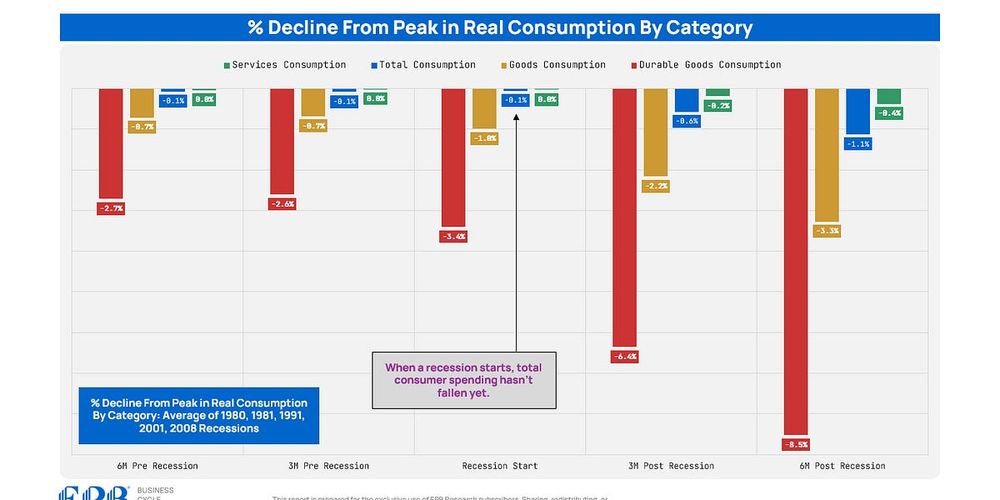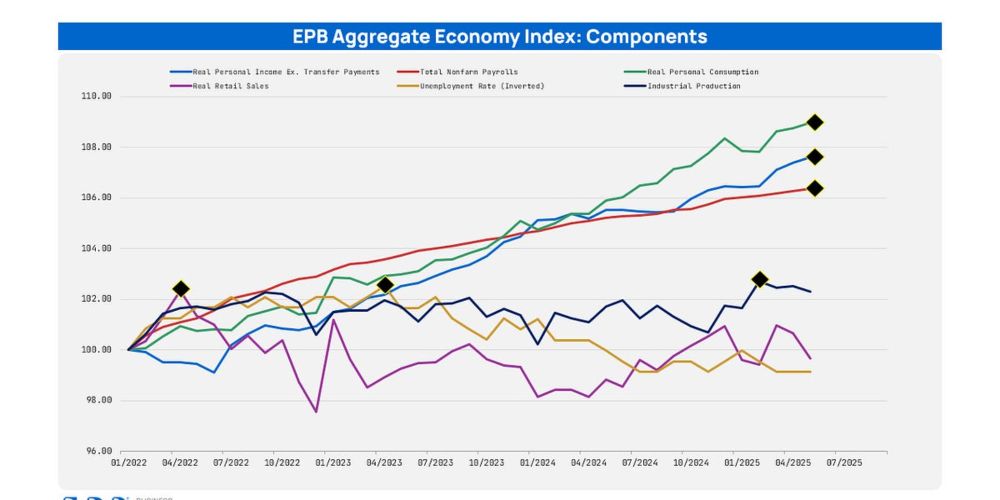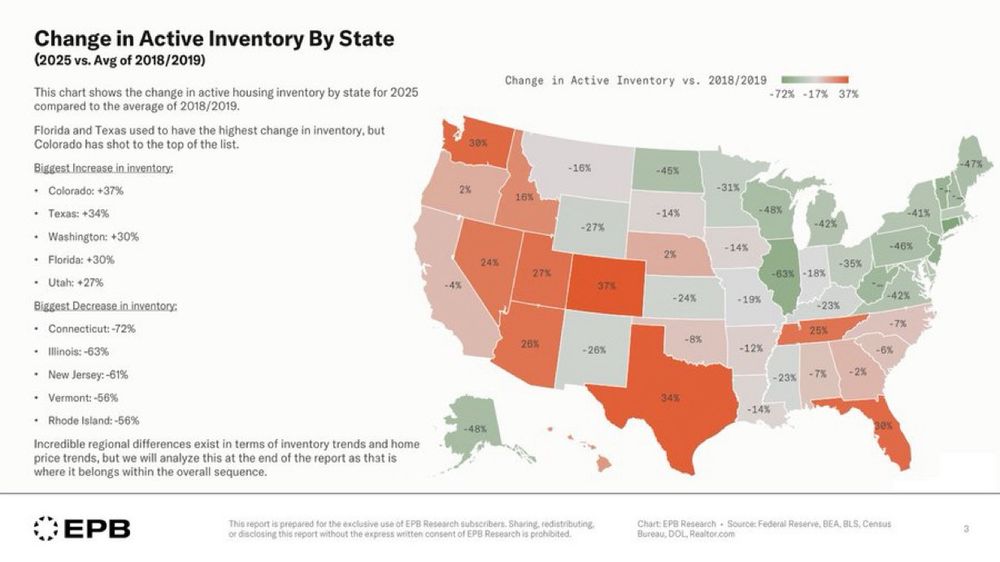
We just released a new video update on residential construction & home prices.
It covers the full housing cycle & highlights major regional disparities in inventory & price trends.
If you're interested in reports like this, you can find more info here: epbresearch.com/services/
08.08.2025 15:44 — 👍 2 🔁 0 💬 0 📌 0
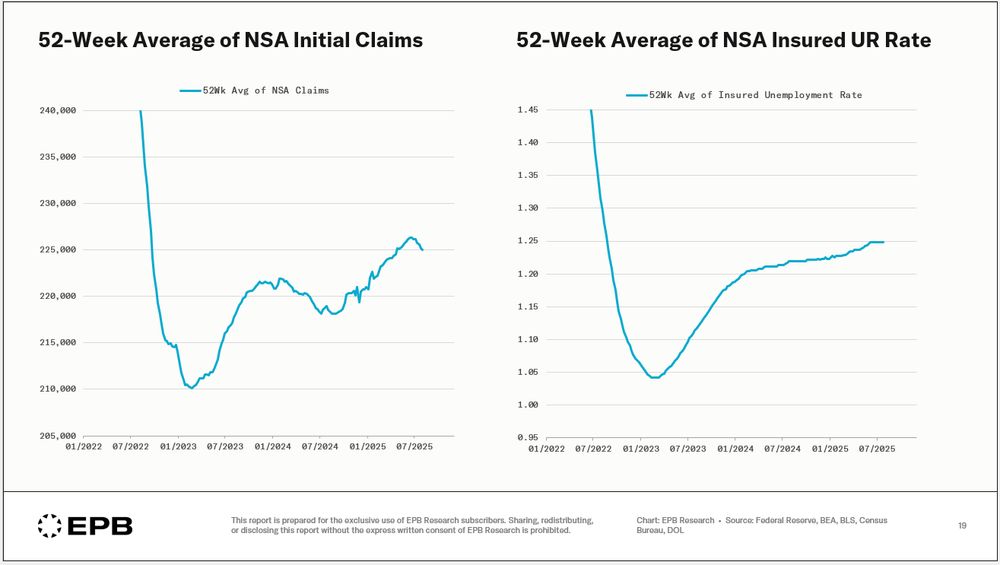
Initial jobless claims have been stabilizing over the last few weeks.
Less so for the insured UR rate.
07.08.2025 18:19 — 👍 1 🔁 0 💬 0 📌 0
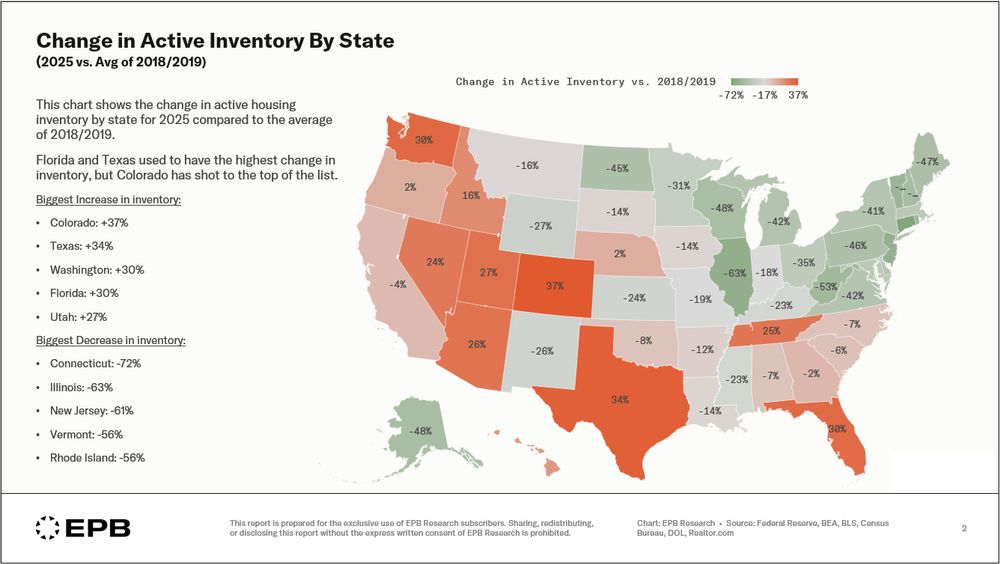
Our next EPB update focuses on residential construction and home prices.
This chart shows active housing inventory in 2025 compared to 2018/2019 levels.
This is the one of the largest variations in inventory and home prices by geography or region in history.
05.08.2025 15:01 — 👍 1 🔁 1 💬 0 📌 1
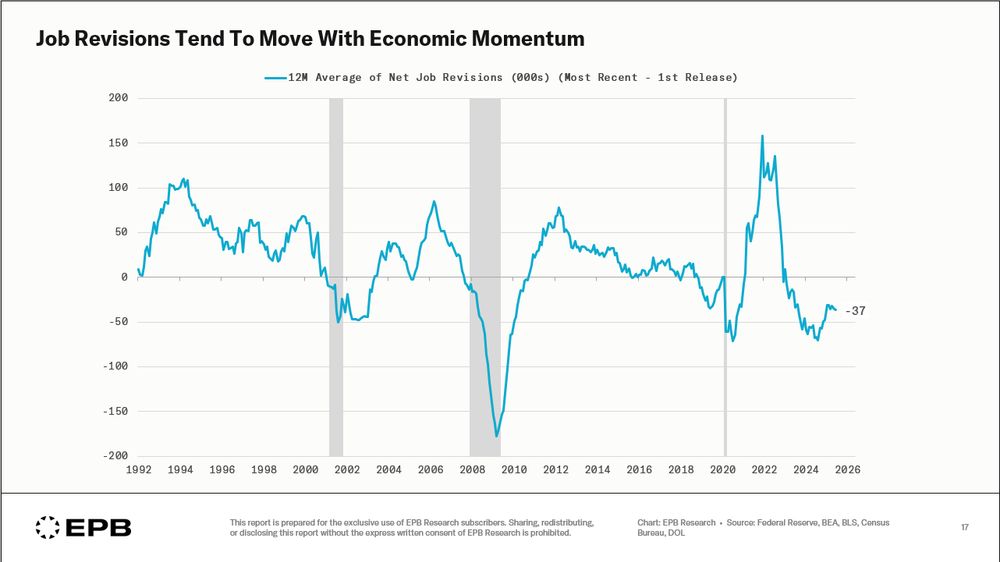
Two comments about the labor data and political noise surrounding revisions:
1] Establishment survey nonfarm payroll revisions tend to move with economic momentum (so much that rolling revisions look like an economic indicator)
2] The unemployment rate is much less revised.
03.08.2025 11:21 — 👍 3 🔁 1 💬 0 📌 0
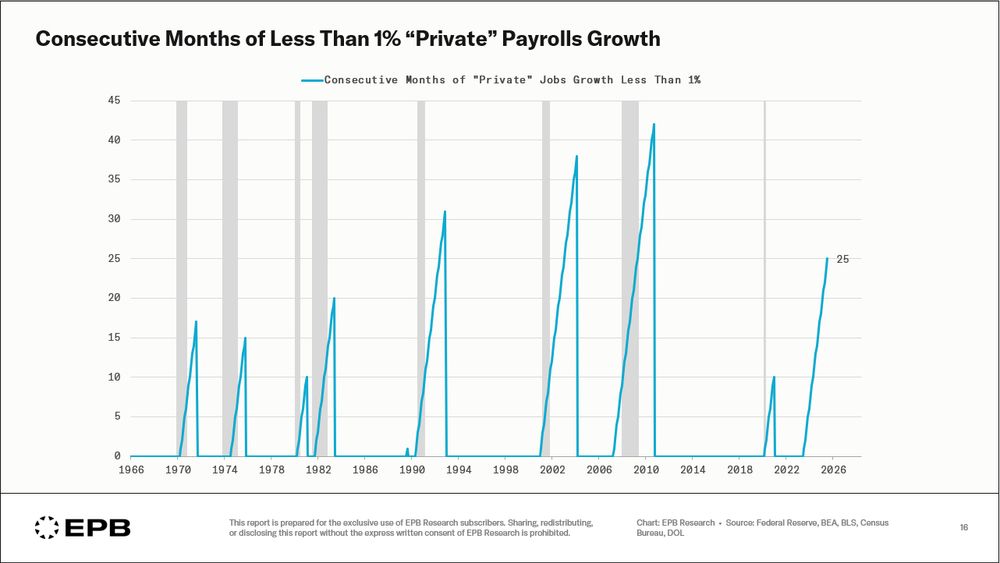
What is different this cycle is the length of time private jobs growth has held below 1% (25 straight months).
Unusual outside of recessionary periods.
02.08.2025 19:24 — 👍 2 🔁 1 💬 1 📌 0
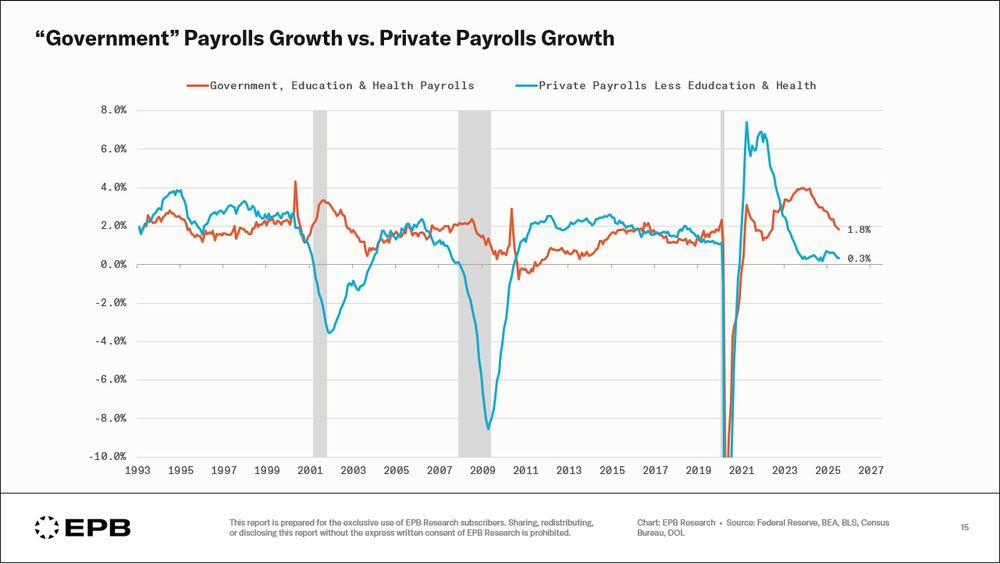
Government & quasi-government jobs (32% of total) are growing at 1.8%.
"Private" sector jobs (68% of total) are growing at 0.3%.
This split is textbook late-cycle labor dynamics.
02.08.2025 19:24 — 👍 1 🔁 0 💬 1 📌 0
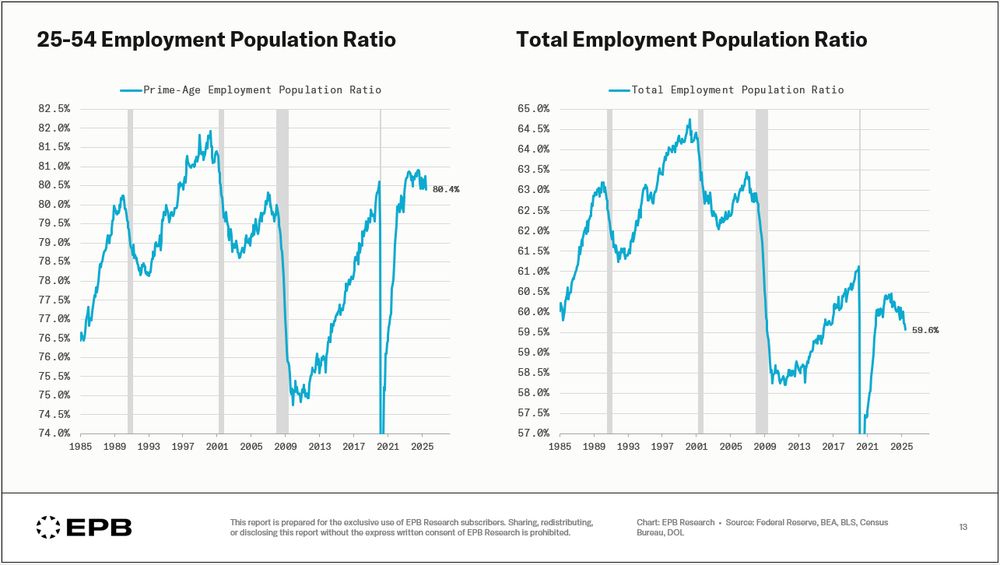
Demographics at play, but yikes, the total employment-population ratio looks bad.
02.08.2025 18:40 — 👍 5 🔁 0 💬 0 📌 0
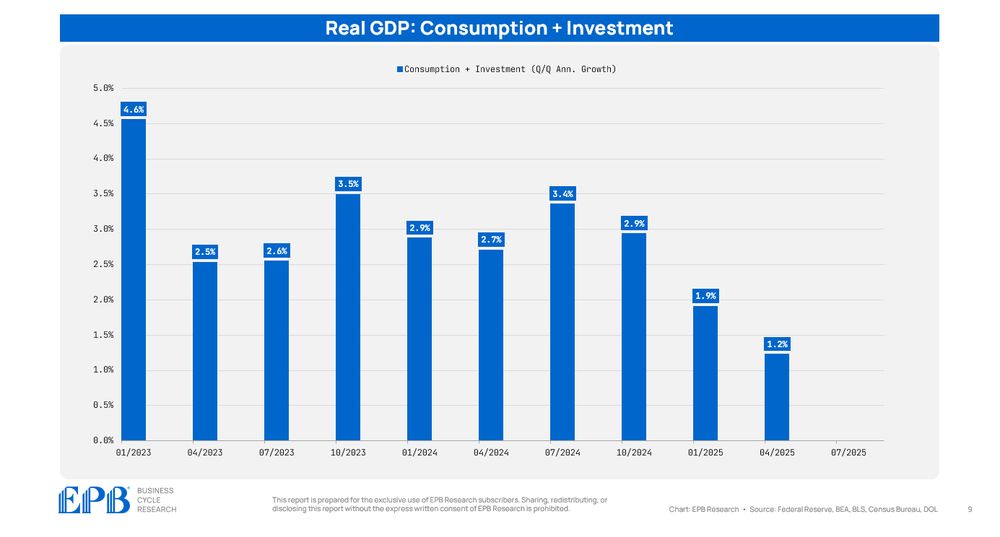
Consumption + investment (87% of GDP) decelerated to 1.2% growth in Q2.
Q324: 3.4%
Q424: 2.9%
Q125: 1.9%
Q225: 1.2%
30.07.2025 16:28 — 👍 3 🔁 2 💬 0 📌 0
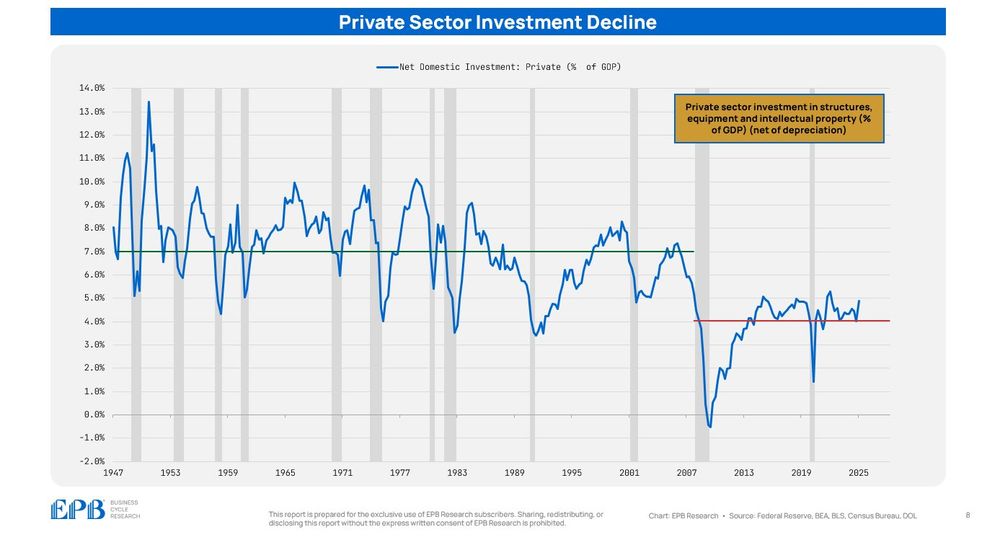
The most effective way for an economy to grow is for the private sector to invest & grow the capital stock.
From 1947-07, the private sector invested ~7% of GDP in new structures, equipment & IP.
From 07-today, it's been ~4%.
This is around $1T of missing investment per year!
21.07.2025 10:33 — 👍 0 🔁 0 💬 0 📌 0
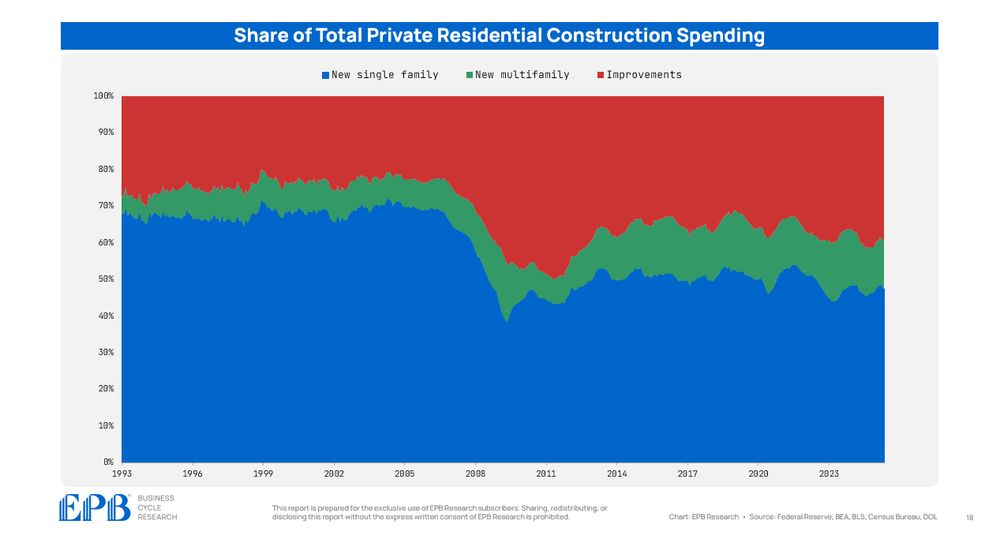
The nature of residential construction spending has shifted.
In the early 90s, 70% of residential construction spending was on new single-family buildings.
Today, it's 47%.
Remodeling and new multi-family buildings have increased their share from a combined 30% to over 50%.
19.07.2025 17:14 — 👍 10 🔁 2 💬 0 📌 0
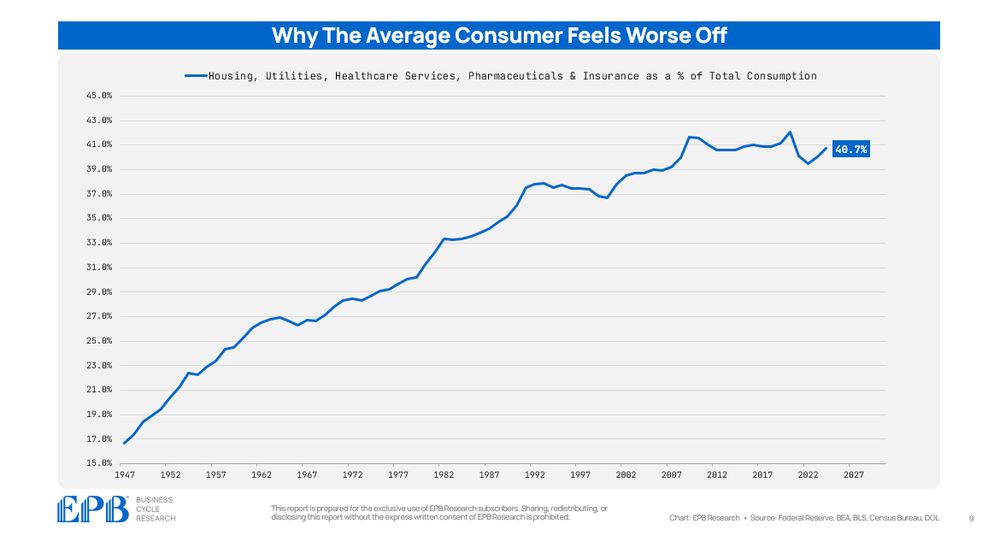
Why does the average consumer feel worse off?
Because 41% of consumer spending goes to: housing, utilities, healthcare, medications, and insurance.
This was 16% in 1947, 30% in 1980, and 35% in 1990.
Fewer consumer dollars are left for true discretionary spending.
15.07.2025 18:40 — 👍 7 🔁 1 💬 0 📌 0
This trend has interesting cycle dynamics.
Rate hikes more directly impact new construction rather than remodeling, which could explain the durability of residential building employment this cycle.
15.07.2025 13:23 — 👍 2 🔁 0 💬 0 📌 0

Residential building is one of the most important categories of employment for the business cycle.
Residential building includes single & multi-family building as well as remodelers.
Remodeling has increased from 30% to nearly 50% of total residential building employment.
15.07.2025 13:23 — 👍 5 🔁 1 💬 1 📌 0
Is it sustainable for an economy to invest in intellectual property but not physical assets like structures and equipment?
Can you invest in AI (IP) without more grid capacity (structures)?
What are the implications of robust IP investment but depreciating physical assets?
13.07.2025 13:10 — 👍 3 🔁 0 💬 1 📌 0
How much money does the government spend per person, adjusted for inflation (2025 dollars)?
1965: $10,400
1975: $15,500
1985: $18,400
1995: $20,100
2005: $23,700
2015: $25,800
2025: $31,000
*this federal, state and local government spending per capita, adjusted for inflation.
12.07.2025 22:31 — 👍 5 🔁 0 💬 1 📌 0
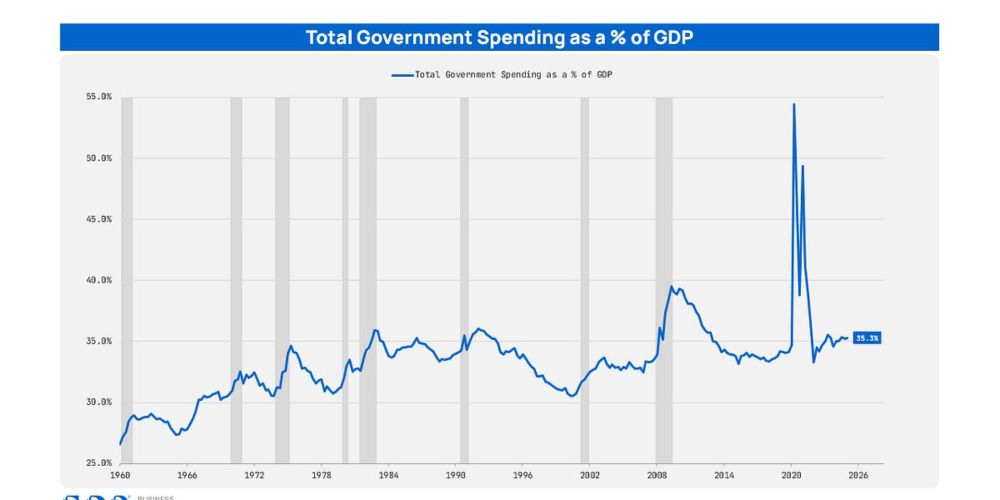
Crowding Out The Private Sector
Unchecked government spending growth is smothering the private sector, eroding productivity and blurring the economic picture for policymakers.
Crowding Out The Private Sector
Unchecked government spending growth is smothering the private sector, eroding productivity and blurring the economic picture for policymakers.
Read the full blog post here: epbresearch.substack.com/p/crowding-o...
10.07.2025 19:10 — 👍 2 🔁 1 💬 0 📌 0
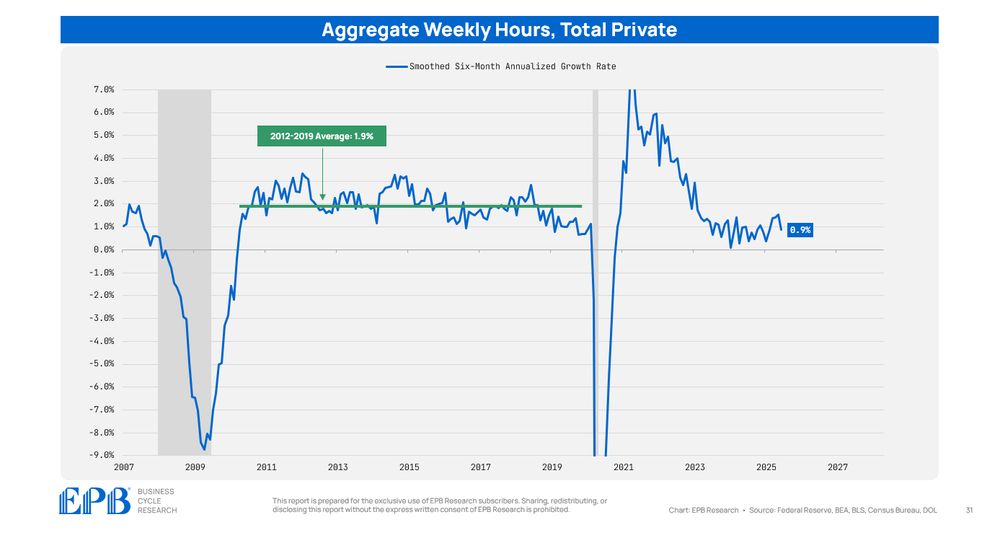
Aggregate hours worked in the private sector are growing at a 0.9% annualized rate.
This compares to an average rate of 1.9% in the pre-pandemic expansion.
The private sector labor market is weak for a non-recessionary period.
09.07.2025 21:08 — 👍 3 🔁 1 💬 0 📌 0

Private sector jobs (excluding education & healthcare) fell to 68% of total jobs in the economy.
Normally, the private sector share of jobs falls in recessions, not expansions.
The labor market gains continue to be dominated by government, and quasi-government jobs.
05.07.2025 16:08 — 👍 5 🔁 2 💬 0 📌 0

How do you solve a primary deficit problem with inflation, when the majority of the primary deficit is indexed to inflation?
04.07.2025 06:10 — 👍 7 🔁 1 💬 0 📌 0
Adding to the debt and claiming we’ll ‘grow our way out’ makes no sense—because it’s the debt itself that’s constraining growth.
You can’t escape by digging deeper.
04.07.2025 06:09 — 👍 7 🔁 0 💬 1 📌 0
Fiscal austerity is like surgery - highly disruptive in the short term but an immediate path to recovery.
More debt is the pain killer - avoids the root cause but compounds the problem, often in slow and insidious ways.
04.07.2025 06:09 — 👍 3 🔁 0 💬 0 📌 0
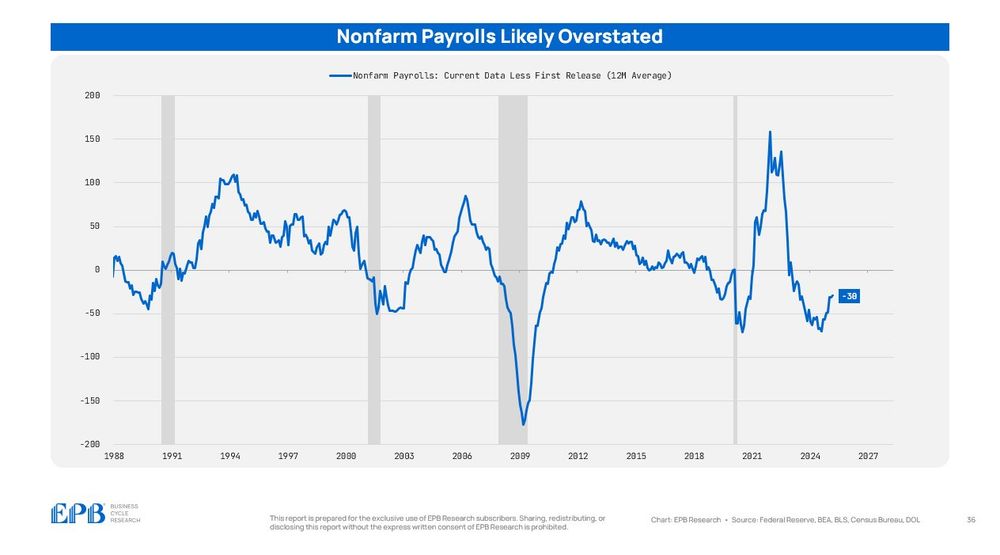
Nonfarm payrolls continue to be overstated.
Over the last 12 months, nonfarm payrolls were revised lower by an average of 30,000 per month.
Current data suggests we are adding ~1.6 million jobs per year. The pace is likely closer to 1.25 million, a 20% difference.
23.06.2025 20:14 — 👍 10 🔁 2 💬 2 📌 0
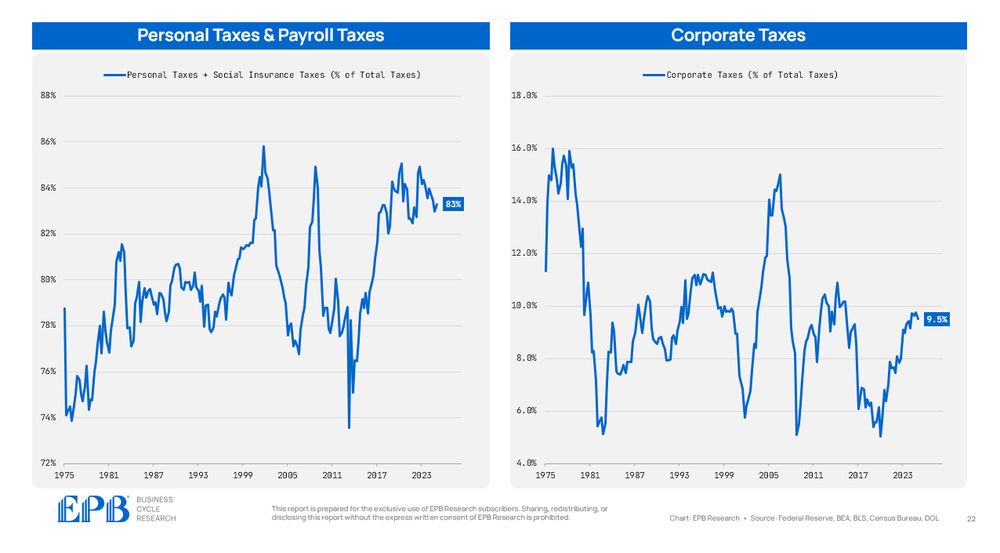
More than 90% of all federal receipts are personal taxes, payroll taxes, and corporate taxes.
Over the last 50 years, more taxes have shifted to personal & payroll and a bit less on corporations.
20.06.2025 18:17 — 👍 2 🔁 0 💬 0 📌 0
Federal government receipts have been relatively stable at 18% of GDP over the last 50 years.
20.06.2025 18:17 — 👍 2 🔁 0 💬 1 📌 0
I’m cool with that as a solution.
19.06.2025 21:52 — 👍 2 🔁 0 💬 0 📌 0
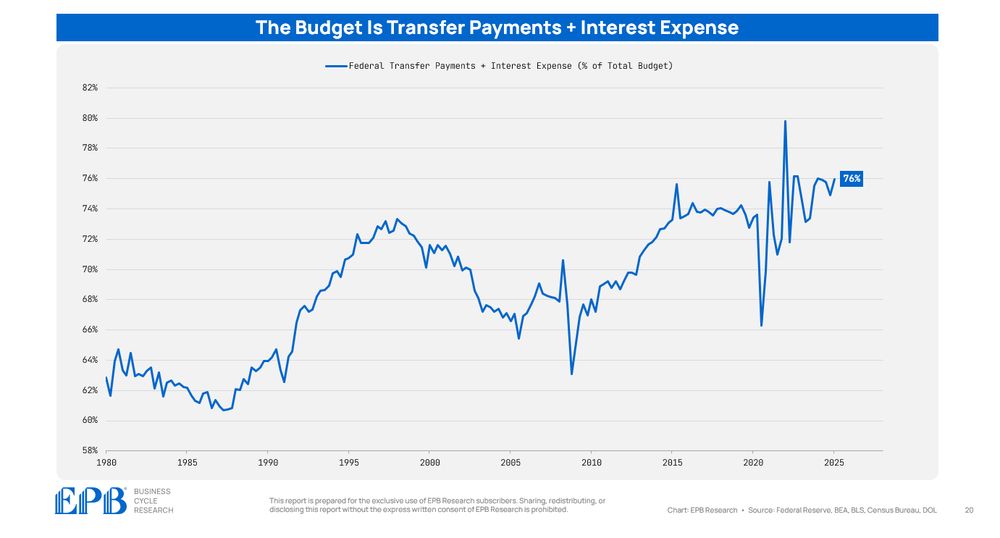
76% of the total budget is transfer payments and interest.
Any budget conversation that doesn't address transfer payments is not a serious one.
19.06.2025 19:32 — 👍 6 🔁 1 💬 1 📌 0
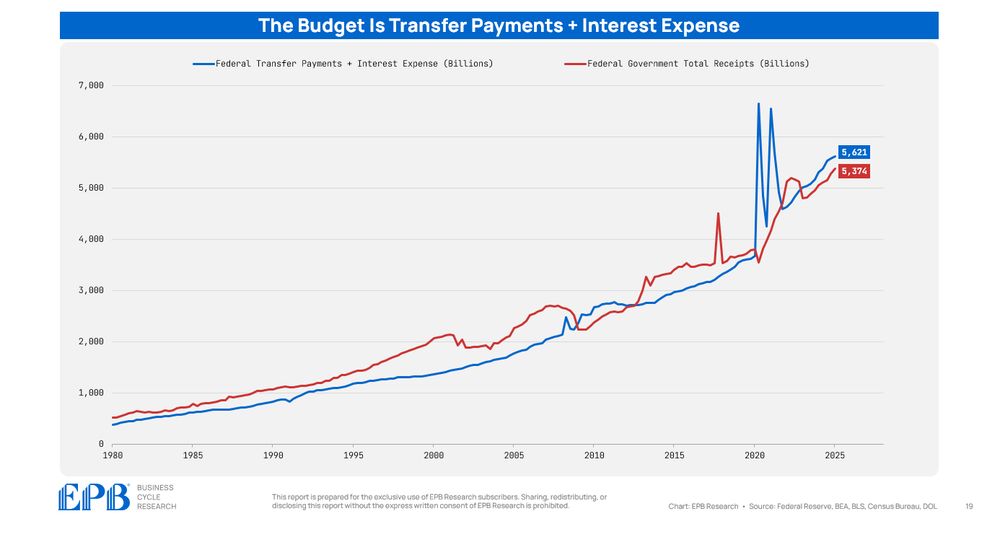
Federal transfer payments + interest expense are larger than total federal receipts.
(Transfer payments are mostly Social Security, Medicare, and state aid for Medicaid.)
19.06.2025 19:32 — 👍 8 🔁 2 💬 1 📌 1








